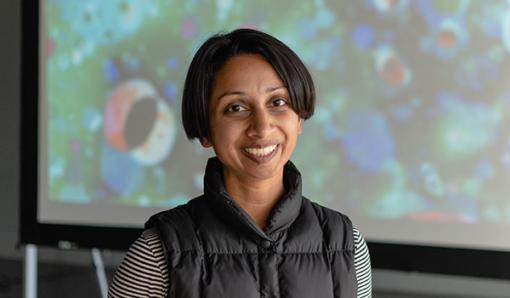
At the beginning of Asha Tamirisa’s time at Oberlin College and Conservatory, she anticipated, given her love of historical musicology, that she’d spend her undergraduate years pursuing a degree in ethnomusicology. However, when she started going to experimental music shows with friends from the computer music department (TIMARA), she began to fall in love with a genre that, prior to college, she had never known existed. Soon after, she, too, began taking classes in TIMARA, fundamentally changing the way that she would design the rest of her degree.
*[Click here for a mobile-friendly version]*
“It just felt like these performers were really present with each other and with the space that they were in. [They] were really sculpting something in that moment.”
Shortly after Asha began taking computer music courses, the department brought sound artist, performer, and composer, Laetitia Sonami, to the Oberlin stage. During this performance, Sonami played her signature instrument—the lady’s glove—and focused on movement, mindfulness, and her interface, instead of on performing technical feats or conveying technical prowess. Blown away by Sonami’s stage presence and approach to technology, Asha began developing an interest in feminist science and technology studies. Following this interest beyond her undergraduate years, Asha decided to pursue an M.A. in Modern Culture and Media, in addition to a PhD in Computer Music and Multimedia (MEME) at Brown University.
At Brown, Asha has primarily worked with sound and video in performance and fixed media. In addition, she’s loved collaborating with others through improvisation and site-specific performances. More generally, though, she finds great joy in putting her work into dialogue with what someone (or something) else is doing, including the decisions that someone else is making in another medium and how the space around her is responding. In her solo practice, she tends to put media into dialogue with each other, paying attention to what images and sound are doing individually, while also considering how they’re working with and against each other. Finally, Asha’s great love of history often encourages her to work with older technologies.
Shortly after arriving at Brown, for example, Asha learned that the MEME program had recently rehabilitated a synthesizer from the 1970s. Having never worked with analog synthesizers before, Asha’s curiosity took over — after familiarizing herself with the synthesizer’s interface and with how many of those particular synthesizers were still functioning, she created a “digital emulation of [this] historical synthesizer,” culminating in what would be her masters project.
“[When we work with] the destabilization of historical narratives … I like that not only are we rethinking the past, but we’re also rethinking the present.”
Asha’s dissertation screening, Lossy Recollections, is a project that also wraps itself around concerns for how the past touches the present. Primarily motivated by media archaeology, feminist science and technology studies, and subaltern (postcolonialism) studies, Lossy Recollections investigates events from the past that weren’t well-documented, weren’t well-archived, or involved some sort of trauma. Derived from the complex ephemera that were produced from these instances, Lossy Recollections is composed of five short films: “Cut,” “Vitarana," “Vanishing Point,” “Record,” and “Lossy Recollection.”
The first film in Lossy Recollections, “Cut,” was motivated by “cutters.” In the early 1900s, young, working-class female film editors were referred to as cutters. Because women were assumed to be good at handiwork and at empathizing with characters in film, film industry giants believed that these women were especially adept at constructing compelling narratives. In spite of their incredible contributions to American cinema, however, cutters were and continue to be scarcely recognized for their work. In a way, these women have been cut out of the narrative of film history. By interacting with elements of visibility, invisibility, film reels, and spinning wheels, “Cut” calls attention to cutters’ historical narratives.
The next video, “Vitarana,” is centered on transference. One summer, Asha’s family went through Asha’s mother's and grandmother’s belongings, deciding how their old materials would move through Asha’s generation. During this process, Asha’s family reflected on stories that she had never heard before. Created with the awareness that Asha will never fully understand all of the memories that are absorbed into her family’s keepsakes, “Vitarana” is a personal meditation on her family's heirlooms.
The third short film, “Vanishing Point,” is an intimate piece that considers the role that images play in memory from a personal instance of grief and loss. In this picture, Kate Bergstrom, graduate of the Brown/Trinity Rep MFA Program, narrates a prose poem that is accompanied by projector slides — ephemera of this personal loss.
In the fourth piece, “Record,” Asha manually manipulates a vinyl record player to create “different collages of sound” that drive a text-generation software program. When an austere, masculine voice extends from the record player, text that was culled from a testimony about gender-based aggression appears on the screen. By looking at how life is absorbed into records and at how the record is engineered to not reveal everything, “Record” attempts to present other critical information, effectively disrupting the record’s orbit.
Last, Lossy Recollections' fifth, eponymous short is a “playful, material exploration of the artifacts of degradation.” Featuring footage from an old, hand-painted 16mm that Asha recently found on a hard drive, “Lossy Recollection” is the product of playful yet purposeful subtractive processes. By performing manipulations such as subtracting color information and exporting at low quality using the incorrect codec, Asha reveals a beautiful piece that is also, at times, “a little scary.”
About the Author
Dominique Moore ‘18.5 is a percussionist and science fiction writer. When she’s not thinking about music and dystopian societies, she can be found spending time with friends in the CIT. To chat with Dominique about this piece (or anything else), reach out to her at dominique_moore@brown.edu.